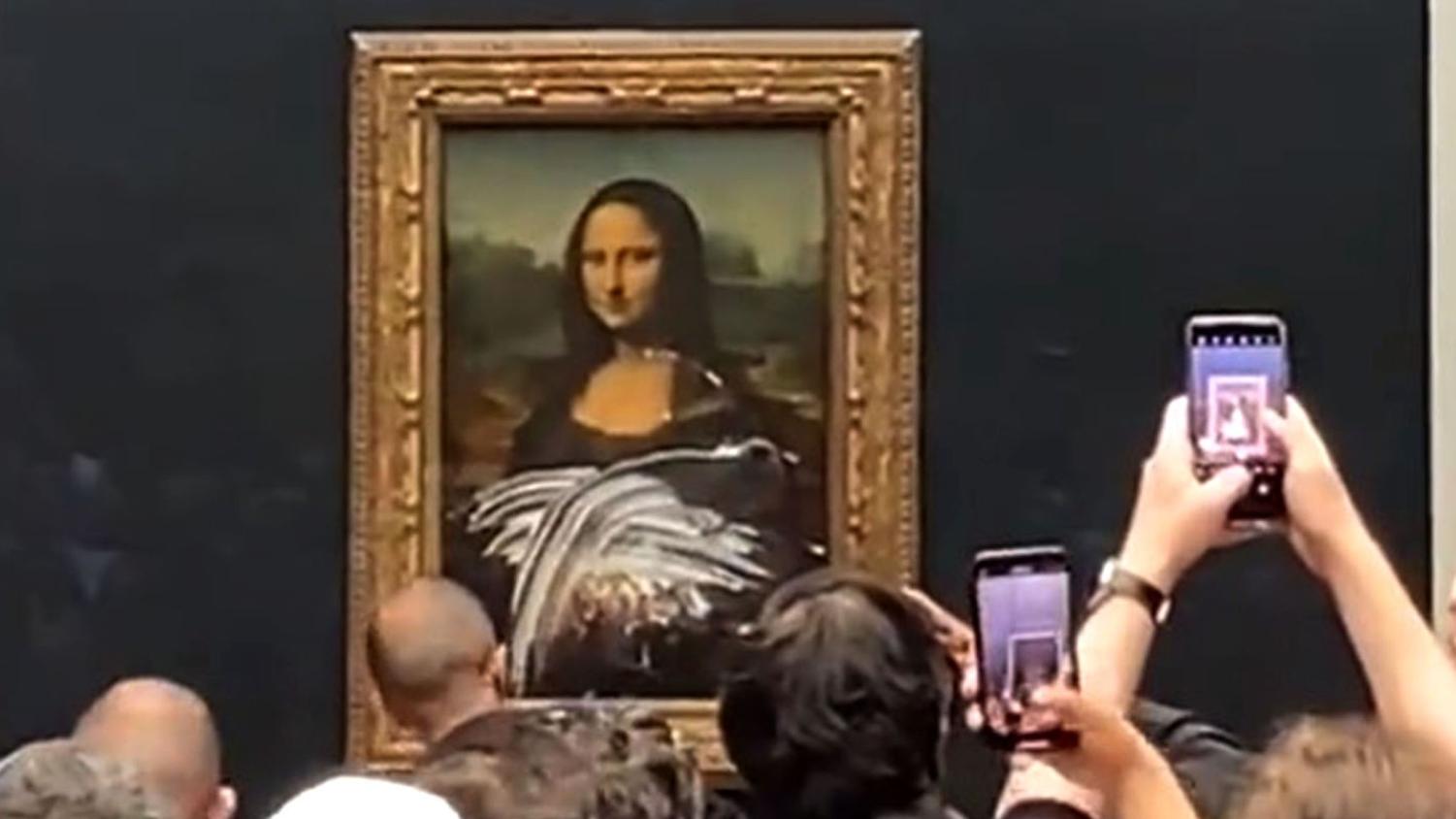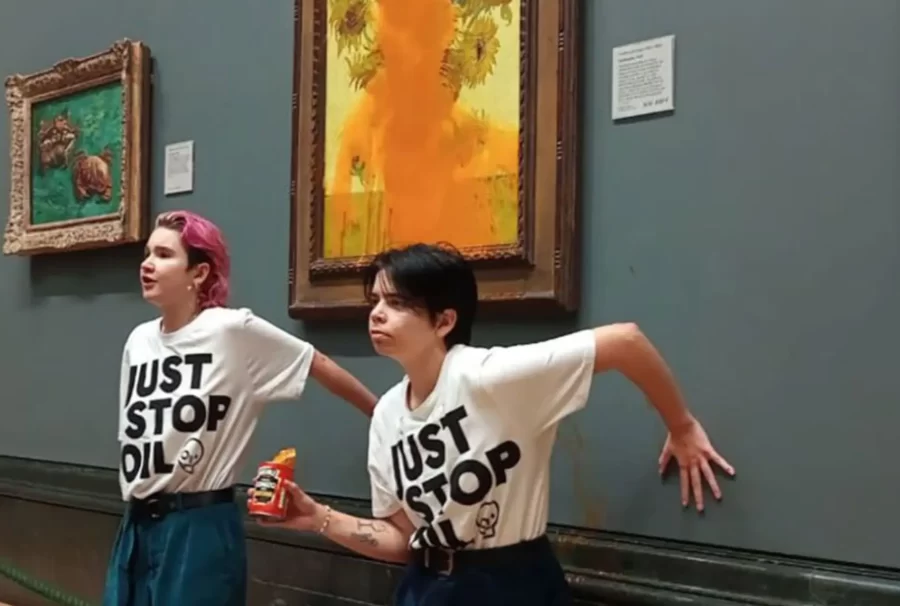Meme protests: The true unforeseen consequence of the Industrial Revolution
Activists pose after dousing Van Gogh’s “Sunflowers” with tomato soup.
March 23, 2023
If you were to ask anyone in the 19th century about the potential consequences of the Industrial Revolution, not a single soul would have ever imagined responding with a sentence like “smeared cake on the ‘Mona Lisa.’” Strangely enough, a direct consequence of the Industrial Revolution is a popular protest movement that involves desecrating famous artworks with food.
Vincent Van Gogh’s “Sunflowers” (1888) is one of the most well-known artworks in the world. With gorgeous warm tones, realistic petals and soft brushstrokes, what’s not to love? In October 2022, however, the artwork was retouched with hues of tomato red — courtesy of a can of tomato soup from members of the Just Stop Oil campaign group. In a bold protest against oil companies and the government’s inaction on both the cost of living crisis and the climate crisis, the activists dumped an open can of soup over the painting and glued themselves to the wall.
Although the stunt, fortunately, did not leave an impact on the artwork itself, it left an impact on the world.

Since this protest inspired a surge of activism against notable artworks across the world, Van Gogh is no longer alone in this new wave of food-based advocacy against climate change. In recent months, works by Leonardo da Vinci and Claude Monet were also targeted by both food and statements challenging whether the worth of art is greater than the lives of people. Although the protests have received widespread criticism from politicians and environmental groups, activists continue to transform assorted canned goods into tools for change.
But that’s not all — climate activists have taken even more drastic measures, capitalizing on both art and their physical bodies to draw international attention. In March 2023, a topless protester targeted popstar sensation Avril Lavigne at the 2023 Juno Awards in Alberta, Canada. Bearing drawings on her torso advocating for environmental action to be taken against oil pipelines, the logging of old-growth forests and development in the Ontario greenbelt, this protester turned herself into the art rather than the typical means of defacing a famous work. In this instance, activists resolved to target musical artists, in addition to transforming their own bodies into art, as a means of drawing in (no pun intended) even more international attention.
Out of all these protests, why is the one common denominator art?
Using art as a means of protest against institutions is nothing new. Throughout history, humanity has both developed art and targeted popular imagery to protest against institutional conventionality. From Dadaism, which was an art movement invented and utilized as a means of protesting political unrest during the early 20th century, to graffiti which is created and displayed in public places to advocate for social and political change, to the toppling of confederate statues in public parks to “decolonize” modern society from hateful views of the past — art has played a key role in shaping humanity’s ability to communicate a need for change.
Together, combinations of art, institution and activism are proven to be a powerful recipe for drawing attention to significant issues and changing the status quo. So why has the world been captivated by this one string of protests in particular? Oddly enough, the answer to that question cannot be found through historical analyses of protests against institutions because, as aforementioned, that truly is nothing new.
The answer lies at our fingertips — memes.
Yes, I am referring to the satirical (and often nonsensical) visual sensations of the internet. In this era of memes and GIFs, the influence of striking and symbolic imagery has become a globalized phenomenon that permeates the boundaries of both space and cyberspace. People across the world are more inclined to recognize and resonate with significant imagery, as our generation has been trained to embrace visual media culture. Concurrently, visual culture, shifting to reflect the perspectives of an ever-modernizing era, has adapted to appeal to the masses.
I argue that memes are to blame for the cultural reckoning brought about by the canned food incidents.
Each incident directly affects pieces of artwork and artists (whether visual or musical) that are highly recognizable and renowned worldwide. Artwork often sustains the unique ability to transcend temporality, and the targeted works and artists, in particular, are known for their significant historical, symbolic and popular value. When activists combine their contemporary perspectives with cultural messages of the past, the artwork’s meaning is revitalized to become accessible and impactful for a new generation. By repeating this form of protest across artworks and space, activists across the world can visually “retweet” their message in mass, thus generating a powerful impact for today’s world. Does this process sound familiar? If it reminds you of memes, you are correct, as the spread of memes involves the visual popularization of phenomena across time. Essentially, this scenario is a meme IRL (in real life). LOL, right?
The Industrial Revolution was the spark that triggered the mass production of everyday commodities and brought about the dawn of new technologies, including (eventually) the internet. With the globalization of the Internet came the instantaneous mass dissemination of visual media across bodies of people. Activists, astutely aware of the power of imagery, initiated protests that would leave a memorable, satirical and sensational impact on viewers across the globe — and they succeeded.
Although I do not condone the actions of these protests, their approach and execution is admirable. That’s just some (canned?) food for thought, in case you were wondering a little more about what made these protests so successful. Would it be appropriate to end this article with a TTYL, or am I pushing the limits of my own joke?














